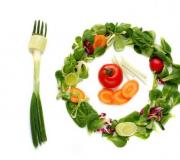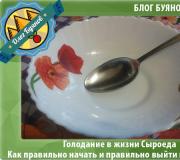Lesson notes 1 ml g dishes guests. Lesson on speech development in the younger group “Visiting Katya”
Purpose of the lesson:
Systematization of children’s knowledge on the topic: “Dishes.”
To form children’s understanding of dishes and their purpose;
Enrich your vocabulary on the topic. (cup, saucer, teapot, candy bowl, teaware, saucepan, spoon, knife, fork, cutlery, frying pan, plate, dishes, eat, drink, cook, fry, etc.).
Cultivate initiative in verbal communication with others;
Develop a desire to solve riddles;
Develop figurative movements through play.
Develop logical thinking, creative imagination.
Develop emotional responsiveness.
Equipment and materials: Cards with illustrations of dishes, Dunno doll, musical accompaniment, children's dishes, poems, riddles, dummies of treats.
Progress of the lesson-game.
Educator:
There's one game for you
I'll read the poems now.
I'll start, and you finish,
Answer in unison.
Where the answer is, there is the end.
Who can tell me - well done.
Granny cooks soup for us in it,
There is (a saucepan) on the table -
Card with a picture (guess) - pan
It is necessary for us
After all, we eat food from it.
Deep and shallow they call it... (a plate).
Card with a picture (guess) - plates
She is always honored in the kitchen,
She both fries and bakes.
We cannot prepare food without a kitchen (frying pan).
Card with a picture (guess) - frying pan
On the stove is the boss of the pots.
Fat, long-nosed (teapot)
Card with a picture (guess) - teapot
Educator: Well done!
How can we name all the objects that we guessed? (Dishes)
What other utensils do you know?
Where can you most often see dishes? (In the kitchen)
And now Dunno invites us to the kitchen. He will show and talk about dishes and how we need them. He will talk, and we will listen and observe carefully, and if he needs our help, we will definitely help.
Dunno (approaches the playing area) - staging of a poem by E. Nikolaeva with a demonstration.
I'll cook now.
I'll put the dishes on the table.
Here, a saucepan, a ladle,
Frying pan, fork, spoon.
Small table knife
I'll need it too.
Here, with plate patterns,
Cup and saucer on a napkin.
And, of course, it is no coincidence
The kettle is smoking on the stove.
Educator: Dunno told us and showed us everything correctly?
But before we continue the story about the dishes, we will move around a little and play.
(Children form a circle. The teacher is in the center of the circle, reads the text and shows the movements that the children repeat)
Knock - Knock - Knock, Knock - Knock - Knock.
(They knock their fists against each other.)
A loud knocking sound is heard.
A loud chime is heard.
(They stomp their feet, hands on the belt).
Ding-ding-dong, ding-ding-dong.
It's the spoons dancing in the kitchen,
Forks, cups, ladle.
(Tilt left and right arms with a shelf in front of the chest).
Tra - ta - ta, tra - ta - ta
All the dishes started dancing!
(Perform a “spring”, hands on the belt).
Kettle lid here, there!
Spoons in a cup - knock, knock!
And the pots - boom - boom!
(“Dance”, alternately placing forward on the heel
left and right legs, hands behind your back).
Frying pans - don - don!
This is how the dance is beautiful!
Tra-ta-ta, tra-ta-ta!
(Clap their hands.)
Educator: Now let’s take our seats and continue our conversation.
Guys, name the dishes from which you drink tea? How to call a cup, teapot, saucer, sugar bowl in one word? (tea)
Name the dishes from which you eat soup, porridge... (plate, spoon). What is the name of this dish in one word? (dining room).
Name the utensils in which food is prepared (pot, frying pan, ladle) What is the name of this utensil? (kitchen).
Educator: Guys, the trouble is, Dunno visited us recently, helped me wash the dishes, and put them on one table. But each dish should have its own place.
Help me take it apart. First, tell me, into what groups can the dishes be divided?
Children: dining room, kitchen, tea room.
Educator: Well done, you know. Now get to work: place the tableware on the first table, and the kitchen utensils on the second. on the third - a tea room. Look, make no mistake!
(children complete the task)
Dunno: now let’s check if you have arranged the dishes correctly?
What kitchen utensils did you bring to this table? What is a frying pan for? Kettle?
What pieces of tableware are on the table? What is a knife for?
Name the items of tea utensils. What are tea utensils used for?
Dunno: Well done, you know everything.
Educator: Well done, guys! And now our fingers are tired, let's play with them.
Finger gymnastics: “Dishes”.
The girl Irinka was putting things in order.
Show thumbs up.
The girl Irinka said to the doll:
“Napkins should be in a napkin holder,
There should be oil in the oil can,
There should be some bread in the bread bin,
What about salt? Well, of course, in a salt shaker!”
Alternately connect the thumb with the rest.
Educator: And also, guys, geometric shapes live in dishes.
Dunno: How is that possible? What other figures?
Educator: Listen, guys, tell Dunno what geometric figure lives in the frying pan? (Circle) And what is the geometric figure in the spoon? (Oval) In a saucepan and ladle? (Circle) What kind of figure lives on the cutting board? (Rectangle) That's right, guys, you're great!
Educator: Our next journey into the world of dishes has ended, let's remember what we learned new and interesting today. (Children's answers, farewell to Dunno.)
Goals: clarify the name of the dishes with the children; be able to name and distinguish between kitchen, dining and tea utensils; be able to name parts of dishes and external signs; form genitive case nouns, with diminutive suffixes, adjectives from nouns; agree numerals with nouns; make sentences with prepositions; activate the dictionary on this topic.
Equipment: demonstration material - dishes and pictures of dishes; handouts - plot pictures.
Progress of the lesson
1. Organizing time
The one who names several objects (plural nouns) will sit down: cup, saucer, plate, glass, glass, teapot, mug, herring bowl, frying pan, salt shaker, etc.
For example: cup-cups, glass-glasses, etc.
2. Conversation about dishes
How can all these objects be called in one word? (dishes)
What other utensils do you know?
Name the cutlery that we use for eating? (Spoon fork knife)
What kind of container is used to cook food? (Pot, frying pan, baking sheet, etc.)
What is the name of the dishes? (Kitchen)
What utensils do we use when drinking tea? (Cup, saucer, sugar bowl, teapot, candy bowl, etc.)
What is the name of this dish? (Tea room)
What is the name of the dishes from which we eat (take food)? (Dining room)
Name the tableware. (Deep plate, shallow plate, tureen, salad bowl, salt shaker, herring bowl, etc.)
Dishes on display:
a) a saucepan with a lid.
What parts does the pan consist of? (Wall, bottom, lid, handles).
(The teapot and glass are treated similarly.)
b) Comparison of utensils: frying pan and jug.
3. Game exercise “Match action words to objects”
a) The teapot stands, is poured, poured out, topped up, washed, dried, wiped, cleaned.
b) Sugar bowl - put, pour out, take, pour, scatter.
c) The pan is closed, placed, cleaned, poured, etc.
d) Cup - drink, pour, pour, drink, etc.
The teacher displays pictures of dishes.
Name the utensils that are made of metal? So what are they like? (Metal.)
(Similar: plastic, porcelain, glass, aluminum, wood, cast iron, etc.)
4. Physical education minute
|
Here is a large glass teapot, Very important, like a boss. |
Children "inflate" their bellies one hand on the belt, the other curved like a nose. |
|
Here are the porcelain cups Very fragile, poor things. |
Squat down, one hand on the belt. |
|
Here are the porcelain saucers, Just knock and they will break. |
They spin around, drawing a circle with their hands. |
|
Here are the silver spoons |
Stretch, hands up, close over your head |
|
Here is a plastic tray- He brought us the dishes. |
make a big circle. |
5. Ball game
Formation of nouns with a diminutive suffix: cup-cup, spoon-spoon, etc.
Didactic game "Count".
Making sentences based on plot pictures using prepositions.
6. Teacher's story
People have been using utensils since ancient times. At first it was wooden. Russian national dishes remained wooden and clay. Then glass, metal, earthenware, and porcelain dishes appeared. Services appeared. People are very careful about dishes, because they can break, and the work of the person who made them is lost. The dishes are washed, cleaned, wiped so that they are always clean and pleasant to eat from. How to care for dishes: first, remove plates and cups from food debris, then wash them with hot water and soap or other detergents, then rinse them thoroughly. They put it in the dryer, wipe it and put it in the closet.
7. Summary of the lesson
Be able to distinguish and name kitchen, dining and tea utensils. Know the external signs of the utensils and their purpose. Write a descriptive story about a kettle, a saucepan according to the plan: name; external signs; what is it made of? appointment.
"Dishes"
Program content: Teach children to form simple sentences.
To consolidate children's knowledge about dishes and their purpose.
Exercise children in operations with words: use in a diminutive form, coordinate nouns with numerals, one-many.
Equipment: illustrations, cut-out pictures on the topic.
Move.
Children, all of you come to me, stand in a semicircle. Now look at your chairs, what is on them? That's right, these are cut pictures. You need to collect them and name what is drawn on them. Well done. How can we call all these objects in one word? (dishes).
Now listen to the riddles Whoever guesses what it is raises his hand.
When I'm empty
I forget about you
but when I bring food,
I won’t pass by my mouth?
They are made of glass
Intended for
Tea, juice, milk?
I'm puffing, puffing, puffing,
I don't want to get warm anymore.
The lid rang loudly -
Drink tea! The water boiled.
Well done, you solved the riddles very well and quickly, let's see if you can complete the next task, which is called “who is more”, for each correct answer you will receive a chip.
What kind of mug? Beautiful, new......
What kind of pan?……….
What kind of knife?…..
What kind of frying pan?…..
Well done, now let's count who has more chips.
Now let's play an interesting game “1,2,3,4,5”
1-cup, 2-cups, 3-cups, 4-cups, 5-cups.
Kettle ……..
Plate……
Spoon….
Saucer….
Pot….
Pan….
Also interesting material for younger preschoolers:
Now let's play with our fingers.
Finger game “We washed the dishes.”
Well done guys played with our fingers well.
Now we get up from our chairs and make a circle. And our game will be called “One Many”
I throw the ball, I say cup, and the one who caught it says cups.
Cup, spoon, pan, mug, spoon, knife, plate, glass.
Good guys, give me the ball and take your seats.
“What are dishes for?”
What do we drink from? we drink from a mug.
What do we eat soup with?……
Where do we pour the soup?…..
What are we frying on?….
how do we cut food?….
How many of you can name the dishes we talked about today?
Well done.
Did you like our lesson?
Today you answered my questions very well, and for this I want to give you these medals with these circles drawn on them.
Title: Summary of educational activities in the junior group for speech development “Dishes”
Position: teacher
Place of work: GKUZ KO KDRS "Warm House"
Location: Kemerovo, Kemerovo region, Russia
Summary of a lesson on speech development for the younger group
Topic: "Dishes"
Goals:
1. Fix the names of the main utensils.
2. Reinforce the use of prepositions in speechon the.
3. Mastery of a general conceptdishes.
4. Teach children to accurately follow verbal instructions.
5. Form a phrase, teach how to construct simple sentences correctly, and develop coherent speech in children.
Equipment:
Visual and didactic aid “Dishes”
Cut pictures (3-4 parts)
Set of children's dishes
Teddy bear
1 . Organizational moment
Educator: The one whose name I call affectionately will sit down.
Mashenka, sit down. Petenka, sit down, etc.
2. Main part.
Game "Collect broken dishes"
Educator: Children, today Mishutka came to visit us. He had trouble: he was washing dishes at home and broke them. Let's collect Mishutkin's dishes and see what he broke? The teacher distributes cut-out subject pictures to each child and repeats the instructions again.
Educator: Nastya, what are you collecting?
The child finds it difficult to answer.
Educator: Here is a sample of your picture, now you will succeed!
Educator: Egor, what did you get here?
Egor: Cup.
Educator: What is the cup for?
Egor: You can drink from a cup.
The teacher also interviews all children who are not doing well and helps.
Educator: Well done. You all helped Mishutka.
Physical education minute
Improvisation of movements to the beat of a poem.
I take the cup in my hands
And I bring it to my mouth,
I bow my head
I drink the tea to the bottom.
Game "Find the dishes."
Various utensils are scattered around the room.
Educator: Now we need to clean up the room, and Mishutka will help us.
The teacher demonstrates for Mishutka: I found a teapot. There was a kettleon shelf.
Children find dishes, approach the teacher and say:
The cup wason table.
The saucer wason carpet
The pan wason semi.
The plate wason chair, etc.
Educator: Well done, guys. Now our room is tidy and we can play.
Game “Friends or not friends?”
The teacher shows the children two objects each and asks:
Is the cup and pan friendly? (Yes, these are dishes)
Is the plate on friendly terms with the hat? (No, because a hat is not a dish).
Is the kettle friends with the tractor? (No, because a tractor is not a utensil), etc.
Physical education minute (the round dance game “Image the dishes” is played). Children stand in a circle and perform movements representing dishes, under the guidance of the teacher:
Here is a large glass teapot (children inflate their bellies)
Very important, like a boss (put one hand on the belt, bend the other like a nose)
Here are the porcelain cups: very fragile, poor things! (squat, one hand on the belt)
Here are porcelain saucers: just knock and they will break! (they spin around, drawing a circle with their hands)
Here are the silver spoons: a head on a thin leg (stretching, arms clasped above the head)
Here is a plastic tray: he brought you dishes! (lean forward, arms also extended forward, as with a tray).
Game “Listen carefully, do diligently”
Educator: Now let’s check which of you is the most attentive. You should put only those utensils that Mishutka needs on the tray. Sasha starts. (Then the teacher calls the children one by one.)
Take a glass, plate and cup.
Take a saucer, a teapot and a frying pan.
Take a pan, a lid and a cup, etc.
Educator: All the children turned out to be very attentive. Well done!
3. Summary:
Educator: Children, what did we talk about today?
Children: About dishes.
Educator: Let's remember in what kind of dishes we cook food, and from which we eat, from which we drink. The teacher interviews the children one by one.
Educator: Well done, guys. You played and practiced very well.
Summary of a lesson on speech development for the first junior group
Topic: "Dishes"
Goals:
1. Fix the names of the main utensils.
2. Reinforce the use of the preposition na in speech.
3. Mastery of the general concept of dishes.
4. Teach children to accurately follow verbal instructions.
5. Form a phrase, teach how to construct simple sentences correctly, and develop coherent speech in children.
Equipment:
Visual and didactic aid “Dishes”
Cut pictures (3-4 parts)
Set of children's dishes
Teddy bear
1. Organizational moment
Educator: The one whose name I call affectionately will sit down.
Mashenka, sit down. Petenka, sit down, etc.
2. Main part.
Game "Collect broken dishes"
Educator: Children, today Mishutka came to visit us. He had trouble: he was washing dishes at home and broke them. Let's collect Mishutkin's dishes and see what he broke? The teacher distributes cut-out subject pictures to each child and repeats the instructions again.
Educator: Nastya, what are you collecting?
The child finds it difficult to answer.
Educator: Here is a sample of your picture, now you will succeed!
Educator: Egor, what did you get here?
Egor: Cup.
Educator: What is the cup for?
Egor: You can drink from a cup.
The teacher also interviews all children who are not doing well and helps.
Educator: Well done. You all helped Mishutka.
Physical education minute
Improvisation of movements to the beat of a poem.
I take the cup in my hands
And I bring it to my mouth,
I bow my head
I drink the tea to the bottom.
Game "Find the dishes."
Various utensils are scattered around the room.
Educator: Now we need to clean up the room, and Mishutka will help us.
The teacher demonstrates for Mishutka: I found a teapot. The teapot was on the shelf.
Children find dishes, approach the teacher and say:
-The cup was on the table.
-The saucer was on the carpet.
-The pan was on the floor.
-The plate was on the chair, etc.
Educator: Well done, guys. Now our room is tidy and we can play.
Game “Friends or not friends?”
The teacher shows the children two objects each and asks:
-Is the cup friends with the pan? (Yes, these are dishes)
-Is the plate friends with the hat? (No, because a hat is not a dish).
-Is the kettle friends with the tractor? (No, because a tractor is not a utensil), etc.
Physical education session (the round dance game “Imagine the dishes” is held). Children stand in a circle and perform movements representing dishes, under the guidance of the teacher:
Here is a large glass teapot (children inflate their bellies)
Very important, like a boss (put one hand on the belt, bend the other like a nose)
Here are the porcelain cups: very fragile, poor things! (squat, one hand on the belt)
Here are porcelain saucers: just knock and they will break! (they spin around, drawing a circle with their hands)
Here are the silver spoons: a head on a thin leg (stretching, arms clasped above the head)
Here is a plastic tray: he brought you dishes! (lean forward, arms also extended forward, as with a tray).
Game “Listen carefully, do diligently”
Educator: Now let’s check which of you is the most attentive. You should put only those utensils that Mishutka needs on the tray. Sasha starts. (Then the teacher calls the children one by one.)
-Take a glass, a plate and a cup.
- Take a saucer, a teapot and a frying pan.
- Take a pan, a lid and a cup, etc.
Educator: All the children turned out to be very attentive. Well done!
3. Summary:
Educator: Children, what did we talk about today?
Children: About dishes.
Educator: Let's remember in what kind of dishes we cook food, and from which we eat, from which we drink. The teacher interviews the children one by one.
Educator: Well done, guys. You played and practiced very well.
Attached files




